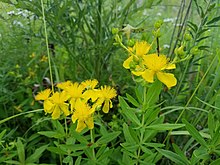
Hypericum is a genus of flowering plants in the family Hypericaceae. The genus has a nearly worldwide distribution, missing only from tropical lowlands, deserts and polar regions. Many Hypericum species are regarded as invasive species and noxious weeds. All members of the genus may be referred to as St. John's wort, and some are known as goatweed. The white or pink flowered marsh St. John's worts of North American and eastern Asia are now separated into the genus Triadenum.
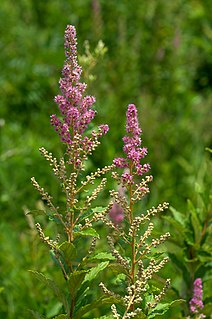
Spiraea tomentosa, commonly known as steeplebush, meadowsweet, or hardhack, or eastern hardhack, is a flowering plant native to the eastern United States and Canada.

Parthenocissus inserta, also known as thicket creeper, false Virginia creeper, woodbine, or grape woodbine, is a woody vine native to North America, in southeastern Canada and a large area of the United States, from Maine west to Montana and south to New Jersey and Missouri in the east, and Texas to Arizona in the west. It is present in California, but it may be an introduced species that far west.
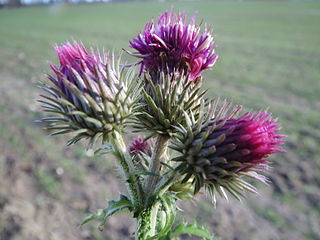
Carduus acanthoides, known as the spiny plumeless thistle, welted thistle, or plumeless thistle, is a biennial plant species of thistle in the sunflower family (Asteraceae). The plant is native to Europe and Asia and introduced in many other areas, where it is sometimes considered an invasive species.
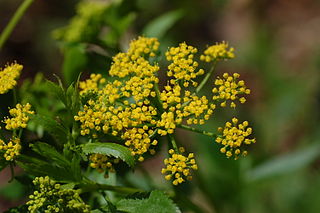
Zizia aurea is a flowering perennial forb of the carrot family (Apiaceae). Golden alexanders is native to eastern Canada and the United States, from the eastern Great Plains to the Atlantic Coast. Named for Johann Baptist Ziz. a German botanist.

Ribes americanum is a North American species of flowering plant in the gooseberry family known as wild black currant, American black currant, and eastern black currant. It is widespread in much of Canada and the northern United States.
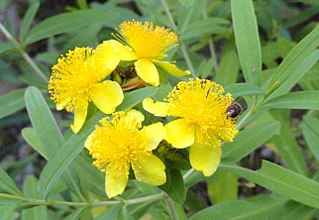
Hypericum kalmianum, commonly called Kalm's St. Johns wort or Kalm's St. Johnswort, is a flowering plant in the St. John's wort family Hypericaceae. It is native to the Great Lakes region in the northern United States and southern Canada. Hypericum kalmianum was named after its discoverer, Swedish botanist Pehr Kalm (1715-1779).
Floristic Quality Assessment (FQA) is a tool used to assess an area's ecological integrity based on its plant species composition. Floristic Quality Assessment was originally developed in order to assess the likelihood that impacts to an area "would be irreversible or irretrievable...to make standard comparisons among various open land areas, to set conservation priorities, and to monitor site management or restoration efforts." The concept was developed by Gerould Wilhelm in the 1970s in a report on the natural lands of Kane County, Illinois and codified for the Chicago Region in 1979.
Dr. Gerould S. Wilhelm (1948–) is an American botanist and lichenologist. He is known as author of several floras of the Chicago Region and the development of the Floristic Quality Assessment methodology, a tool to assess the integrity of natural areas. He is the Director of Research at Conservation Research Institute, a nonprofit organization "dedicated to the promotion of planning, design, restoration, and long-term management of sustainable ecological systems in built and natural environments through applied research, education, and outreach."
Dr. Floyd Allen Swink (1921-2000) was an American botanist, teacher of natural history, and author of several floras of the Chicago region.
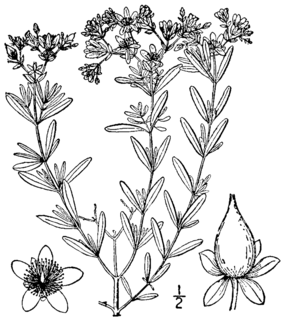
Hypericum densiflorum, also known as bushy St. John's wort or dense St. John's wort, is a perennial herb in the flowering plant family Hypericaceae native to North America. The specific epithet densiflorum is Latin, meaning "densely flowered", referring to the many-flowered cymes.
Laura Rericha-Anchor is an American biologist with expertise in Midwest botany, ornithology, entomology, and ecology.

Hypericum canadense, known as Canadian St. Johns-wort, lesser St. John's wort, and lesser Canadian St. Johnswort, is a flowering plant in the genus Hypericum. It is a yellow-flowering annual or perennial herb native to North America and introduced to Ireland and The Netherlands. The specific epithet canadense means "Canadian".

Hypericum prolificum, known as shrubby St. John's wort, is a deciduous shrub in the genus Hypericum. It was named for its "prolific" number of stamens.

Hypericum tenuifolium, known as Atlantic St. John's-wort and sandhill St. John's-wort, is a species of flowering plant in the St. John's wort family, Hypericaceae. It is native to the Southeastern United States.

Hypericum tetrapetalum, the fourpetal St. Johnswort, is a species of flowering plant in the St. John's wort family, Hypericaceae. It is found in the Southeastern United States and Cuba. It was first described by Jean-Baptiste Lamarck in 1797.
Hypericum myrtifolium, the myrtleleaf St. Johnswort, is a species of flowering plant in the St. John's wort family, Hypericaceae. It is endemic to the Southeastern United States. It was first described by Jean-Baptiste Lamarck in 1797.

Symphyotrichum firmum, commonly known as shining aster, glossy-leaved aster, smooth swamp aster, or smooth-stemmed aster, is a perennial herb native to Canada and the United States.
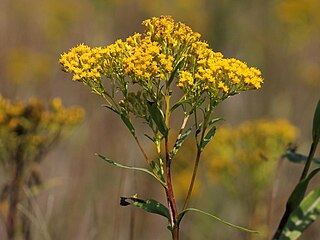
Solidago sect. Ptarmicoidei is a section of flowering plants in the genus Solidago. They are sometimes considered a separate genus: Oligoneuron. Like related species they are known as goldenrods. This section contains seven species of perennial herbs, all native to North America. They are distinguished from other goldenrods by their corymbiform flowerheads, which are flat or rounded in profile and about as broad as tall or broader, for which they are sometimes called flat-topped goldenrods.
